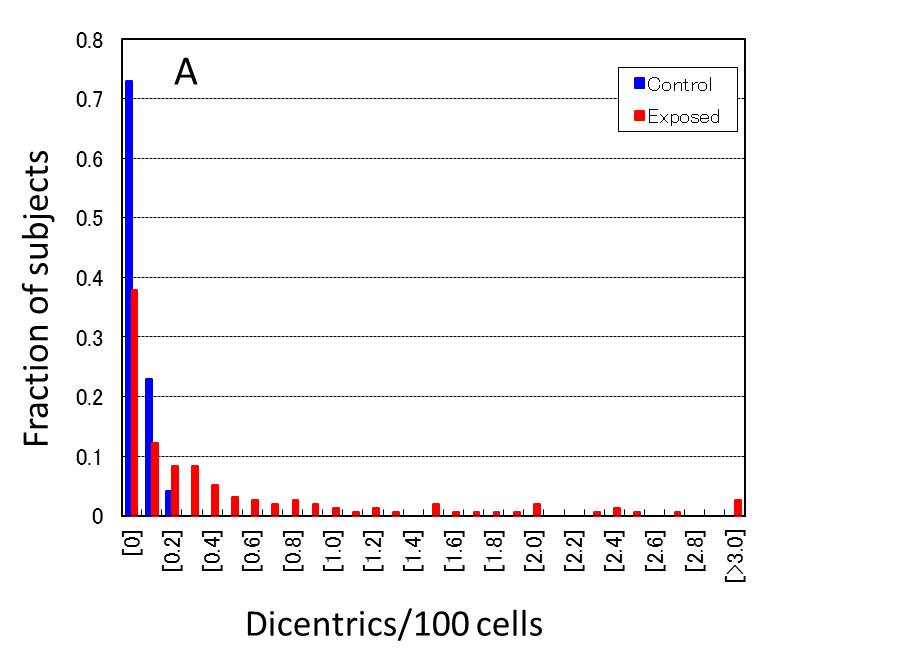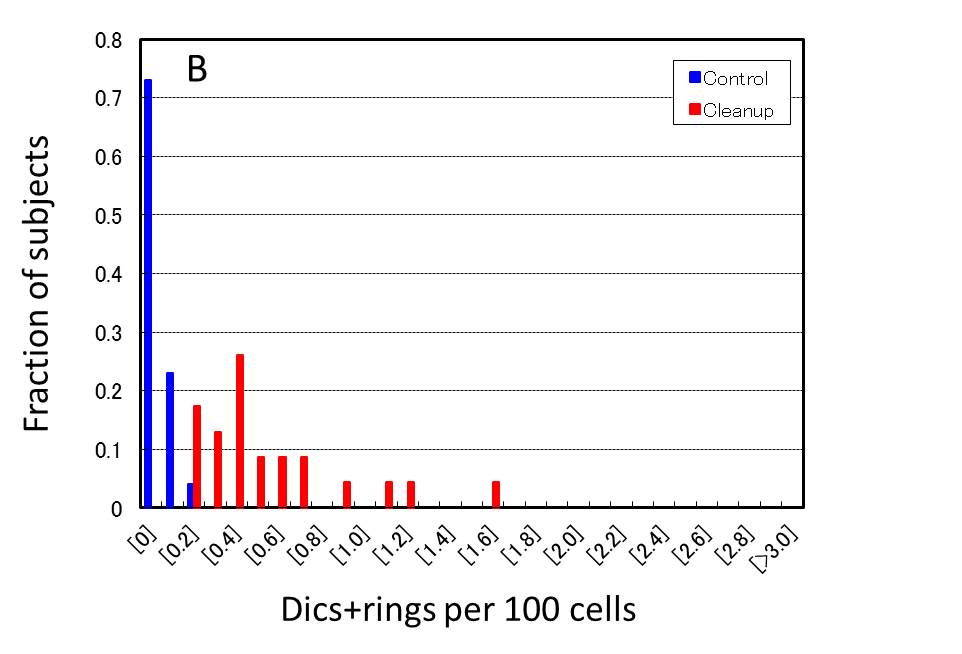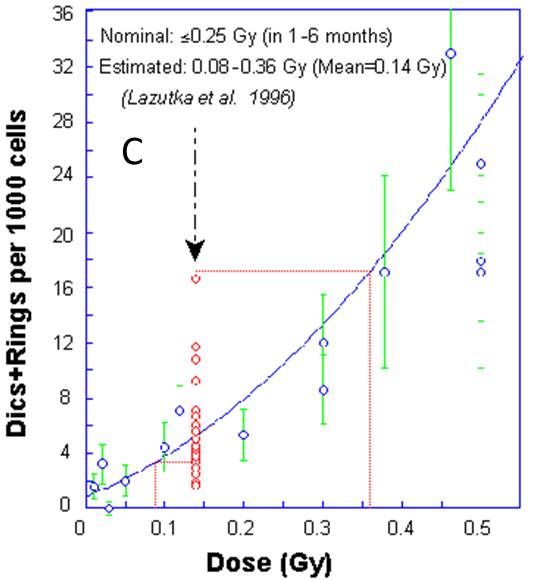-1.jpg)
| Chernobyl: Clean-up workers (Estonia) (Littlefield et al. 1989) |
|
Scenario |
|
Cytogenetic study was performed in collaboration of three high level expert laboratories on 118 cleanup workers from Estonia who participated in cleanup activities in Chernobyl between 1986 and 1991. Lymphocyte cultures were established and chromosome preparations were made for FISH painting analysis. The chromosome preparations were coded, randomized and distributed to the participating laboratories, i.e., Oak Ridge Institute for Science and Education (ORISE), Lawrence Livermore National Laboratory (LLNL) and STUK-Radiation and Nuclear Safety Authority (STUK), where chromosomes were painted by FISH technology using whole chromosome painting probes for chromosomes 1, 2 and 4. In a separate set of culture, the cultures were treated with BrdU for evaluation of lymphocytes proliferation kinetics by FPG method (This was made independently from cultures for FISH staining and performed in ORISE and STUK laboratories). Control cultures were established from 29 Estonian population controls who never traveled to Chernobyl, and from 21 American healthy adult men. |
|
Reference |
|
Littlefield, L. G., McFee, A. F., Salomaa, S. I., Tucker, J. D., Inskip, P. D., Sayer, A. M., Lindholm, C., Makinen, S., Mustonen, R., Sorensen, K., Tekkel., M., Veidebaum, T., Auvinen, A. and Boice Jr., J. D. (1998): Do recorded doses overestimate true doses received by Chernobyl cleanup workers? Results of cytogenetic analyses of Estonian workers by fluorescence in situ hybridization. Radiat. Res., 150:237-249. |
|
Chromosome aberration analysis |
|
In the translocation assay by FISH as expressed
by a genome equivalent frequency, FG(tr), a significant positive correlation was observed with age at the time of blood sampling. The translocation
frequencies were also related to smoking. In contrast, a negative
response was obtained for documented exposure dose. The translocation frequency
(translocations per 1000 genomes) was expressed by: |
-1.jpg)
Figures A and B were each reproduced from panel A and B in Figire 1 of Littlefield et al. (1998), respectively.
| Comentary on translocation assay for low doses of low LET radiation |
Since
reciprocal translocations, if they are not coexisted with unstable aberrations
within a cell, are thought to be inherited by daughter cells when they attempted
at cell division, the attempts have been made to use translocation assay as a
measure of retrospective radiation dose. This has been confirmed in moderate or
high dose exposure given in relatively short time, such as radiation accidents,
A-bomb survivors and radiotherapy patients.
The development of FISH technology brought
us very sensitive method to identify chromosome translocations and was expected
to be a sensitive measure of low dose and low dose-rate exposures. However,
unexpectedly the method came to meet some difficulties particularly in the
cases of low doses and low dose-rate irradiation with low LET radiation that
could not simply be explained by the dose-rate effectiveness and uncertainties
in physical dose assignment.
When relationship between chromosome aberrations and physical doses were
evaluated by unstable aberrations, such as dicentrics, we can find reasonable
correlation. This can be clearly seen in the dicentric assay (see fugures
below).
A: The apearance of lymphocytes carrying dicentric aberration in residents
or evacuees of Chernobyl contaminated area (Stephan and Oestreicher 1989,
Sceid et al. 1993, Verschaeva et al. 1993, Bauchinger 1995, Sasaki, unpulished).
B: Persons carrying dicentrics and/or rings in Lithuania cleanup workers (Lazutka 1996). Blue bars represent distribution in unirradiated control persons (Japanese). C: comparison between dics+rings frequencies in cleanup workers (Lithuania) and in vitro dose-response curve for 60Co gammarays.
 |
 |
 |
Unstable aberrations such as dicentrics and
ring are the aberrations that are observed only in cells that have never
experienced cell division since their formation. In contrast, while translocations
in blood lymphocytes are also formed by ionizing radiation, they are also
supplied by errors of DNA replication during hematopoiesis as well. With
this hematopoietic origin, translocations are accumulated with chronological
age even without exposure to radiation
The followings are the figures reproduced from panels A and B of Littlefied et al. (1998) on 118
Estonian cleanup workers as reassessed by moving window averaging, MWA=w20s1.
-2.jpg) |
The translocation frequencies clearly show
a negative response to the documented dose (panel A). The relation to age
is shown in panel B together with translocation frequencies in two general
populations reported from LLNL. Curve (a) is the age response in unselected
general populations in which potential genotoxic lifestyle factors are
not excluded (Ramsey et al., Mutation Res., 338:95-106, 1995). Curve (b)
is the age response in general populations in which potential genotoxic
lifestyle factors, such as smoking habit, are excluded (Tucker et al.,
Mutation Res., 313:195-302, 1994). Their age responses are:
(a) FG(tr)/1000
genomes=2.97+8.06E-5×Age3 (b)
FG(tr)/1000
genomes=2.97+3.04E-3×Age2
Both
lines were constrained to pass through the level in newborn infants (i.e., 2.97/1000 genomes at age 0).
It is likely that the translocation frequency increases with increasing
age until they are engaged in cleanup activity, but radiation exposure
during (possibly even later) cleanup works suppressed further age-dependent
increase of spontaneously arising translocations of hematopoietic origin
including those related with smoking.
Such suppression of spontaneously arising detrimental genetic alterations
by low doses of low LET radiation has been hypothesized by M. S. Sasaki
(J. Radiat. Res., 55:391-406, 2014). Suppression of translocations by low
doses of low LET radiation observed in residents of high natural background
radiation areas, persons exposed to low doses of low LET radiation in their
workplaces (see present database) is consistent with this hypothesis. This
may be an alternative explanation to be considered for the deviation from
LNT hypothesis of radiogenic cancer for low doses of low LET radiation.